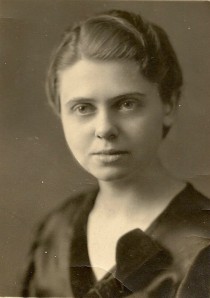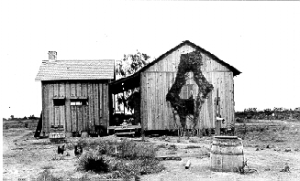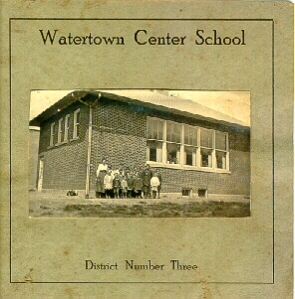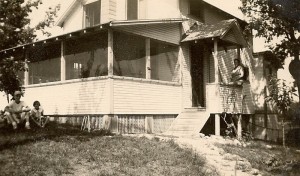The story of the fire that consumed the Bliss house, “The Pivot,” in 1911 was told in a letter from Bel Maier to her cousins:
March 14, 1911
Dear cousins,

The Pivot
So you want to know how it all came about. Well, Uncle Herman and Aunt Dora were eating dinner, just begun, had parsnips and apple grunt with sweetened milk, and warm biscuits. The grunt was still in the oven, where it still reposes, the range being down in the cistern, bottom side up. Something dropped past the south window, and they went to see what, and it proved to be a piece of cornice on fire. Herman started for the pig-pen where the ladder was, and Dora to the telephone. Erma and Mrs. D. Lowell were talking. She asked for the line to turn in the alarm, and of course both women went to tell the men. Uncle C.N. and George were in the front yard, went for pails and started at once. A man by the name of Parks was going by with a load of lumber, and he ran his horses until one laid down when they stopped at Blisses’. The man Parks was good help they all say. Mrs. D. Lowell saw Openlander feeding sheep by his west barn and told him. He started on foot. When he reached the corner, a funeral procession was passing (a lady over in Mr. Goodnoe’s neighborhood, Crofts), and the M.E. preacher was at the head. He took in Mr. Openlander and they both came. (Preacher went back later and did the ceremony.)
I, like a miserable unfortunate, had gone to spend the forenoon at school, and Hazle Daniells was with me. Jake had a man setting up a manure spreader, and Ma had dinner ready and waiting. In some way, she doesn’t exactly know how, she saw some smoke and thought the Bliss house was on fire. In the mean time Dora had told Erma to call other lines, and she left the phone and rang the dinner bell. Our folks had not heard the fire alarm, and thought nothing of the dinner bell at noon, so did not know until they saw smoke. Well Ma said, Jake, I guess Blisses’ house is on fire. He looked and said for Heaven’s sake, and made a dive for the extinguisher. Ma thought he was crazy to come into the house instead of taking a bee line for Blisses’. Next Mr. Corey came out of the barn, thinking as he said that Jake was crazy as he saw him make a dive for the house. Ma yelled at him and he too started for Blisses’ on the run. Mrs. Loomis and Della were sitting in their front window, and they saw Jake and Corey run, and went to the west window to see what they were after and discovered the fire. (I have been at this long enough to burn up several houses, and Rices and my poor miserable self haven’t got there yet.) Well Eddie saw uncle C.N. and George race out with pails and went and did likewise thinking there must be fire somewhere, and when he reached the road saw where.
Now to myself. I had Fan untied and was taking off my blanket when one of Tom’s mill men came by and said Blisses’ house is on fire. I looked up and saw a little smoke, said something expressive, jumped in and tried to hurry Fan, but seemed as if walking would be faster, so took out the whip and soon had the little lady laying straight. Erma was just coming out the yard with pails. She said take my pails and one of the men. Tom and three of his mill men (Ben D., John Welton, and Deverill) were ahead a little way. I slacked up a little, stopped for Tom, and raced on up Rice’s hiss and saw a sight that made me sick, kitchen all on fire and about half big part, with smoke and cinders going directly over Maiers’ house. We had quite a strong south west wind.
Well I dumped Hazle and Tom in front of our house, tied my horse, and went by the back steps, grabbed a pail and got as far as the lilac bush, when Jake came out of the house helping carry some big thing. The men thought it was time he went home and made preparations to save his buildings. It was not safe in the house then for women, so I went home to help Jake carry ladders and get pails of water and watch the roofs.
Now to go back to Dora ringing the dinner bell and Herman getting a ladder. She did not ring long, then went after pails of water. Herman got up on the porch roof and threw one pail of water at the fire (which by this time had spread about half way along the kitchen roof, at first it was blazing only round the chimney). Part of the water came back and made the porch so slippery that he lost his balance. Dora heard him, and he says he started down feet first, but when Dora saw his feet come in sight she grabbed them and then he went down head first from the porch roof. He said he struck on his face and thought he had driven his nose clear into the ground. He cut his chin some, and his head is bothering yet. He went to see the Dr. Friday and he says he has slight concussion of the brain, doesn’t seem to get any worse, and is taking medicine. Now for some more fire news. He went back and Dora handed several more pails of water, much of which came back into Herman’s boots and over his lower extremities. He did not change clothes all afternoon and nearly froze part of the time. Herman also got up the short ladder and fixed it to reach the kitchen roof. Somewhere about here Jake and Corey and the fire extinguisher arrived. (Uncle C.N., George, and Parks close behind.) Jake went up both ladders and turned on steam, and Ma watching from home (she can’t step very lively yet, and her heart was playing tricks so she hadn’t tried to go up) thought they were going to put it out, but the wind was against them. Uncle Herman was up one ladder with a pail of water when Jake came down from the kitchen roof onto the porch roof, threw his extinguisher and kicked out the little window and went into the boy’s room. Uncle Herman dropped his pail of water and started after the ax. You see the attic over the boy’s room was inaccessible, and there was where the fire was. (Uncle C.N. was busy getting water down below, and says when pails and water and extinguishers began to come down from overhead he left.)
Aunt Dora left the porch when the extra men came, and went to clear out the back stair-way, the preacher helping. In this stair way was two bushel baskets of unshelled hickory nuts and one shelled market basket full. All these were carefully saved, also a little peach basket on the back porch containing a dozen more nuts that Mr. Openlander took to clear off the dinner table in. He saved three of Dora’s new teaspoons and two best knives and forks, also a tin of 6 biscuit, the bowl of sweetened milk, and the dirty dishes off the stove. Dora’s first act towards saving things was to help carry out Ma’s new table which they had bought and 1 table leaf. Then she got two wash tubs and put in the dishes from the kitchen cupboard. The churn was saved from the back porch, and a half bushel of parsnips Aunt Dora had just bought, from the east porch, was all that was saved from the kitchen wing. Then Aunt Dora went into sitting room closet after their clothes, and into the bed-room closet and cleared that out, and then Uncle Herman told her she must leave the house. By this time plenty of help had arrived, and all the furniture in sitting, dining, parlor, and bed room was carried out, including pictures, curtains, carpets, in parlor and sitting room. The clock and things on wall of dining room and everything in the built-in cupboard behind the door in this room was lost. Everything in the pantry went. No one event went the room. From the cellar they saved 30 quarts of fruit and 16 bu. of Baldwin apples. They had bbl. of groceries they had just bought with apples, 100 lbs. of sugar, etc., etc.
The last thing Herman did was to go back after Carleton’s and his own fiddle and brought along back the buffalo robe.
Mr. Openlander made a desperate effort to get the cream separator, Eddie got the ax which had been carried down stairs and set out the front door, but the fire broke through the wall and scorched his cheek, at the same time the west walls began to fall. George and Jake and Corey combined saved the bedding from two front beds and front bed-room dresser, had to break off the glass to get down stairs. And when we came to get things together, half of one mattress was gone. I forgot to tell about the ax and Jake. When he got the ax he undertook to chop a hole in the ceiling in the boy’s room near the door and maby head the fire off from the main part. George and Herman were present watching, and all tell the same story, about the 3rd or 4th time he struck the whole ceiling caved in, so you see the fire must have eaten pretty nearly all through the attic of this wing.
About 200 people had gathered by this time and were helping watch our buildings and Loomises’. The grass caught fire near our fence once, and Loomises” straw stack, but as H.P. said, there was men enough around then to cover his stack.
In one hour and twenty minutes the very last stick of timber had burned and fallen. When I went tough the corner to go up, every roof was burning including the front porch roof. They burned just like pasteboard.
It looked pretty tough to see all the things piled together out under the little thorn-apple tree, where the fire had thawed out puddles, some things across the road in the wheat field and mud.
We finally came home and ate our dinner at a little past two. Went back and sort of picked up, and the men put everything in the barn.
Washed dinner dishes at 5, got supper, talked everything over and iffed and supposed and answered telephone till the day was finished. Dora and Herman have put their bed and clothes in my downstairs bedroom. Have got things shaped around some. Herman, Dora, and Lide are making out their list, and it is just something awful. They expect to settle Thursday. Had $1000 on house and $600 on contents.
George saw Dora’s hand bag hanging on stair-door knob and threw it out, but no one picked it up, and her watch which was inside was destroyed. Her pocket book had been taken out to pay for parsnips, and laid on table, so Parks put it in his pocket and it was saved. All the shoes they saved were on their feet, and Dora can’t find her corset, also her best handkerchiefs.
Then in different handwriting:
Tues. morn —- Bel is washing and says sign her name and get it ready.
Bel
Per M.E.B.








 Posted by winegar
Posted by winegar 


 For a number of years, I had had a feeling that I was not yet doing the work which I had been brought into the world to perform. After consulting with some minister friends, I decided to enter the Christian ministry. That decision behind me, I had to secure the necessary educational foundation. A local preacher’s license from my home church at Wacousta was the first step. Admission year work at the Conference Course of Study was the next step.
For a number of years, I had had a feeling that I was not yet doing the work which I had been brought into the world to perform. After consulting with some minister friends, I decided to enter the Christian ministry. That decision behind me, I had to secure the necessary educational foundation. A local preacher’s license from my home church at Wacousta was the first step. Admission year work at the Conference Course of Study was the next step.






















